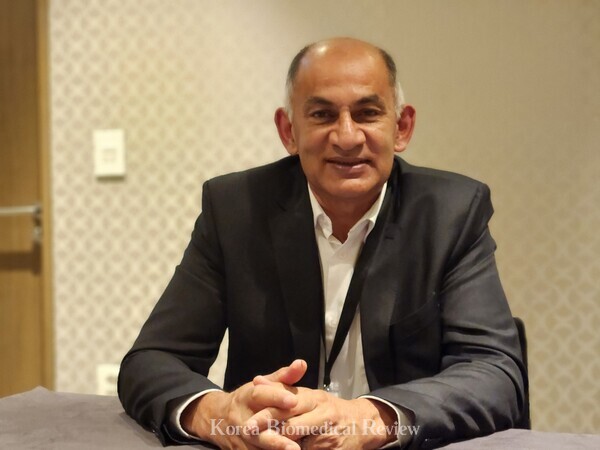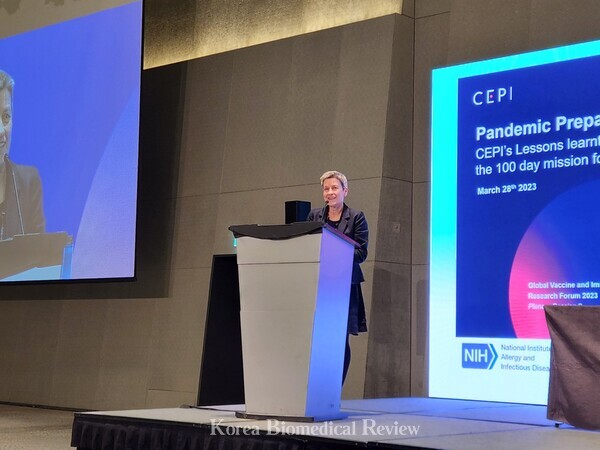The Covid-19 pandemic highlighted the stark global disparities in vaccine access and this spurred regions to start thinking of a regional response to future pandemics such as building regional manufacturing capacity.
Regional manufacturing capacity emerged as a cross-cutting theme in the sessions at the Global Vaccine and Immunization Research Forum (GVIRF 2023) conference.

On this note, Korea Biomedical Review sat with representatives from regional organizations including the World Health Organization (WHO), the Coalition for Epidemic Preparedness Innovations (CEPI), and the African Vaccine Manufacturing Initiative (AVMI) to discover solutions to this issue.
‘Sustainability is the name of the game’
After the Covid-19 pandemic, WHO took the initiative to set up an mRNA vaccine hub in Africa to transfer the necessary human capital for production know-how, quality control, and product regulation to communities for pandemic readiness.
However, WHO’s Coordinator for Vaccine Research Initiatives Martin Friede pointed out the difficulty in finding a sustainable model for the mRNA hub in Africa.

He noted that the WHO would visit South Africa to discuss different business models for the hub in two weeks.
“We will propose different models, but it will not be an easy task,” he stated. “With biotherapeutics, the profit margin is usually high, but with vaccines, this is not the case. You cannot bring the price down and still make a profit.”
Even Moderna is struggling with a similar issue regarding its upcoming manufacturing facility in Kenya, said Friede.
Moderna announced earlier this month that they would invest around $500 million in a Kenyan facility to supply as many as 500 million doses of mRNA vaccines to the continent each year.
However, Friede expressed skepticism accompanied by some sobering facts.
“The entire African continent only purchases around 1.5 million influenza vaccines annually,” he said. “Meanwhile, Korea purchases approximately 30 million influenza vaccines, which accounts for 60 percent of the population.”
This is why the hub will be better suited for manufacturing biotherapeutics when there isn’t a pandemic, he said
“Getting Africa to work together as one unit and not as individual countries will be key for the business models to work,” he said.
WHO previously built vaccine production capacity worldwide to respond to an influenza pandemic, but many of those facilities were eventually closed down, rusted, or became obsolete.
Friede also gave similar comments at a recent meeting regarding the intergovernmental negotiating body (INB) treaty for pandemic prevention, preparedness, and response.
Attempting to learn from these experiences, Friede responded, “We need to ensure that when we build a facility for pandemics, we equip it with a set of tools to remain sustainable.”
Particularly referring to facilities for mRNA, he explained that these facilities should be able to produce other mRNA vaccines or pharmaceuticals which can be produced in a similar facility using the same staff.
“In other words, we need to build multi-use facilities,” said Friede.
‘Access to the market is key to leverage manufacturers’ expertise’
Providing the African context, AVMI Executive Director Patrick Tippoo also admitted it was a big challenge to maintain manufacturing capacity on the African continent.

“Although its complex, establishing capacity is the easy part but sustaining it is where the economics come into focus,” he said, echoing Friede’s comments.
Tippoo added that the facility should be equipped to make vaccines required for routine immunization programs so that when a pandemic comes along, people can absorb technology and repurpose their facilities for the production of that pandemic product.
“In the Covid-19 pandemic, we had facilities but none was fit for purpose at the scale required for making the Covid-19 vaccines,” he elaborated. “mRNA technology has been at the center of regional manufacturing discussions as it only requires a change in the genetic sequence to produce a different vaccine while maintaining the same equipment and workforce.”
Tippoo said that regional manufacturing has not happened in Africa to date because there's no incentive for it yet.
The traditional way of developing capacity is starting from scratch, conducting research and development, and protecting your products until clinical trials, but this carries a risk in terms of investment cost and time, he said.
On the flip side, the accelerated way of doing it is through partnerships by creating a win-win situation by providing the partner with access to the market in terms of a commercial return because vaccine production needs to be economically viable, he added.
Drawing on his experience at Biovac, he shared that his company had secured partnerships with Sanofi and Pfizer for two of their respective leading products, Sanofi Pasteur’s 6-in-1 pediatric vaccine, Hexaxim, and Pfizer’s pneumococcal vaccine, PCV13.
“They only agreed to do this because they had secured the tender for the South African market through a competitive bid for two years. Subsequently, we extended this deal to five years by leveraging technology transfers from the company,” he explained.
Tippoo went on to say, “There is no business case for strictly pandemic production as no investor will finance a company that only intends to produce pandemic vaccines as the opportunity to sell your product may only arise every 10 or 20 years.”
Alternatively, he suggested preparing for a pandemic by building concentric circles of readiness.
“If the readiness plans are well established, you might be able to manufacture the actual product required with this system,” remarked the AVMI official.
He referenced CEPI’S strategy to focus on targeting entire viral families and ensure that there is some preliminary work done so you don’t have to start from ground zero, thereby offering a competitive advantage against the virus.
In regards to the Partnerships for African Vaccine Manufacturing (PAVM) framework for action which aims to manufacture 60 percent of the vaccines Africa consumes by 2040, he explained, “We need to decide which vaccines will make up that 60 percent which will likely be driven by economics and manufacturing capacity.”
He predicted that a subset of vaccines used in infant immunization programs and life-course immunization will comprise that 60 percent.
Strengthening the CEPI 100-day mission, developing prototype vaccines for virus families
CEPI’s Director of Vaccine Development, Melanie Saville, also shared her opinions from an R&D perspective.

CEPI was born out of the Davos conference in 2017 after the Ebola crisis in West Africa, to develop vaccines against emerging infectious diseases.
“Our objective for the first five years was to take vaccines to phase two clinical trials while creating an investigational stockpile, but then the Covid-19 pandemic hit and we were forced to move fast to also include manufacturing in our plan," said Saville.
The director also noted CEPI’s work in surveying global manufacturing capacity so that they could match companies with appropriate vaccine candidates to enable globally diverse manufacturing capabilities.
However, she said, "When the pandemic hit, we were able to be very agile and indeed get into large-scale manufacturing, procuring two million doses worth of glass vials as we realized that the entire global supply of glass vials was in jeopardy and decided to buy some of the vials so that people wouldn't hoard these essential supplies."
One of the key elements of CEPI’s 100-day mission is developing diversified manufacturing networks in the “global south” alongside regional clinical trial networks via decentralized clinical trials or adaptive designs.
CEPI has committed $120 million to engage with manufacturers in the “global south” to build a network of six to eight manufacturers to deliver rapid response capabilities.
Accordingly, she shared that together with the Bill and Melinda Gates Foundation (BMGF), they have already partnered with Aspen in South Africa to preserve the company’s capacity to develop fill and finish vector vaccines.
She added that CEPI holds a 10-year partnership with the Institut Pasteur de Dakar to ensure that they have the tools to respond to outbreaks and also to develop vaccine candidates for its priority pathogens “which we hope will progress to licensure so that vaccines can be manufactured close to outbreak areas.”
CEPI plans to develop prototype vaccines for several virus families.
In particular, she noted that CEPI has already started working on two virus families, namely the arenaviruses like Lassa fever and the paramyxoviruses like Nipah virus (NiV) which they plan to expand over time.
In this regard, she noted the partnership with SK Bioscience for developing mRNA vaccine candidates, one of which is developing a vaccine against the Lassa fever virus.
“mRNA is an important vaccine platform for rapid response and we want to bring more vaccines to this platform,” she explained. “The more data you have on the platform, the easier it will be to work faster when an outbreak emerges."
Regarding the issues surrounding intellectual property (IP) rights interfering with regional manufacturing, she replied, “I don’t think that you need the IP for equitable access but it’s more productive to conduct technology transfers with manufacturers because there's always a lot of know-how but the IP alone will make it challenging to deliver the vaccine without the manufacturer’s help."
The IP alone will not give you the same product as someone else, she reiterated.
“CEPI’s 100-day mission seeks to put all of the pieces of the puzzle together and it will be a process that takes time to achieve the goal of manufacturing vaccines in 100 days but this challenge should not deter us from making a start," she asserted.
Related articles
- [GVIRF 2023] KDCA unveils preview into Korea’s future pandemic response strategy
- [GVIRF 2023] 'Vaccines should be deployed in 6 months in a new pandemic'
- [GVIRF 2023] New innovations in different vaccine platforms
- [Vaccine Innovation] What’s next after mRNA Covid-19 vaccines?
- [GVIRF 2023] The year 2023 is for RSV vaccines, says Johns Hopkins expert
- AstraZeneca’s complementary approach to tackling infectious diseases
- [Vaccine Innovation] How are vaccines saving us from the silent AMR pandemic?
- SK Bioscience to manufacture MSD's Zaire ebolavirus vaccine candidate
- ‘Training future workforce to develop next-gen mRNA therapeutics requires close collab’
- 'CEPI’s 100-day mission only a reality if we establish alternative clinical evidence now'
- IVI Director General highlights balancing vaccine sovereignty with joint global response

